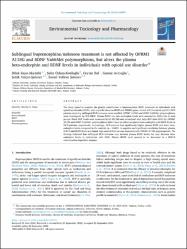Sublingual buprenorphine/naloxone treatment is not affected by OPRM1 A118G and BDNF Va66Met polymorphisms, but alters the plasma beta-endorphin and BDNF levels in individuals with opioid use disorder

Göster/
Erişim
info:eu-repo/semantics/openAccessTarih
2022Yazar
Kaya-Akyüzlü, DilekÖzkan-Kotiloğlu, Selin
Bal, Ceylan
Avcıoğlu, Gamze
Şahiner, Şafak Yalçın
Şahiner, İsmail Volkan
Üst veri
Tüm öğe kaydını gösterKünye
Kaya-Akyüzlü, D., Özkan-Kotiloğlu, S., Bal, C., Avcıoğlu, G., Yalçın-Şahiner, Ş., & Şahiner, İ. V. (2022). Sublingual buprenorphine/naloxone treatment is not affected by OPRM1 A118G and BDNF Va66Met polymorphisms, but alters the plasma beta-endorphin and BDNF levels in individuals with opioid use disorder. Environmental Toxicology and Pharmacology, 95, 103979.Özet
The study aimed to examine the genetic contribution to buprenorphine (BUP) treatment in individuals with opioid use disorder (OUD), with a specific focus on BDNF and OPRM1 genes. A total of 113 controls and 111 OUD patients receiving sublingual BUP/naloxone were enrolled. OPRM1 A118G and BDNF Val66Met polymorphisms were investigated by PCR-FRLP. Plasma BDNF and beta-endorphin levels were assessed by ELISA kits in both groups. Blood BUP levels were measured by LC-MS/MS and normalized with daily BUP dose (BUP/D). OPRM1 A118G and BDNF Val66Met polymorphisms didn't have an effect on plasma beta-endorphin and BDNF levels in OUD patients, respectively. Interestingly, OUD patients had significantly higher plasma BDNF and lower beta-endorphin levels compared to the controls (p < 0.001). A negative and significant correlation between plasma BUP/D and BDNF levels was found. Age onset of first use was associated with OPRM1 A118G polymorphism. The findings indicated that sublingual BUP/naloxone may increase plasma BDNF levels, but may decrease beta-endorphin levels in individuals with OUD. Plasma BDNF level seemed to be decreased in a BUP/D concentration-dependent manner. © 2022 Elsevier B.V.

















